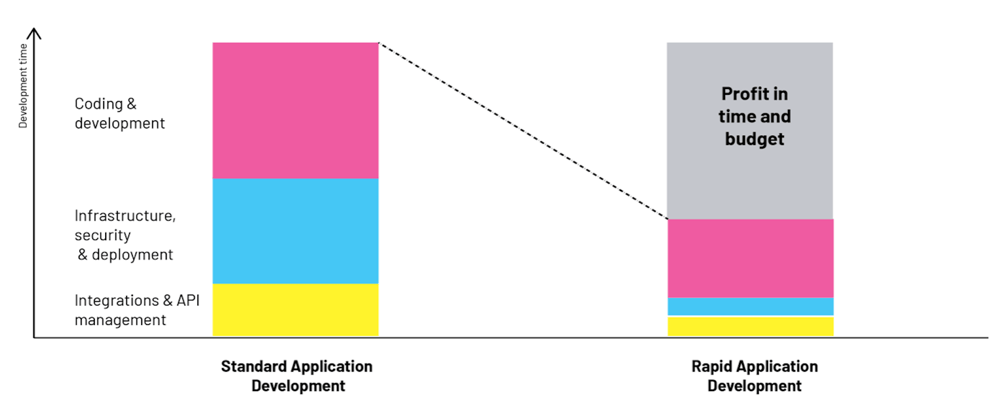Build applications fast,
reliably and future-proof

What is Rapid Application Development?
Do you operate with an <out-of-the-box> mindset? Then RAD is definitely your way to go.
Rapid Application Development is an agile software development approach that focuses more on ongoing software projects and user feedback and less on your strict development schedules. As such, it emphasises rapid prototyping rather than meticulous planning.
Although it is often mistaken for a specific methodology, Rapid Application Development (RAD) reflects the idea that we should treat our software projects like malleable clay rather than solid steel (as seen in traditional development practices).
Ready to accelerate?
4 reasons to dive into Rapid Application Development
More efficient development processes which reduce both the time and expense of development.
Faster time-to-market for internal and customer-facing systems and tools.
Increased innovation, allowing organisations to capitalise on creativity and respond faster to changing businesses and customer demands.
Fewer technological problems thanks to more consistent compliance with standards and safety regulations.

RAD Methodology explained
Although practices and tools vary among specific methods, our underlying phases for the rapid development of applications remain the same:
Define requirements
Instead of spending months developing user specifications, RAD actually starts with defining a loose set of requirements. We say <loose> because one of the key principles of Rapid Application Development is that the requirements may change at any point in the development cycle. Basically, our developers collect the "essence" of the product. We let you provide your vision and come to an agreement with our developers on the ultimate product requirements.
Start prototyping
In this phase of rapid application development, our developers’ goal is to build something that they can demonstrate to you. This may be a prototype that meets all or only some of the requirements (as in early prototyping).
This prototype may cut corners to reach a working state, and that’s totally acceptable! Most RAD programming approaches include a wrap-up phase in which developers pay off the technical debt accumulated from early prototypes.
Absorb feedback
With a final prototype in the making, our RAD developers present their work to you or your end users. They gather feedback on everything, from interface to functionality. It is at this stage that product requirements can be scrutinised.
Of course you’re allowed to change their minds or discover that something that looked good on paper does not make sense in practice. After all, they are only human too, right? With the feedback as a guide, our developers return to a form of step 2: they continue prototyping. If the feedback is entirely positive, and you are satisfied with the prototype, developers can move on to step 4.
Finalise the product
During this phase, our developers can optimise or even re-engineer their implementation to improve stability, maintainability and agility. They can also devote this phase to connecting the back-end to production data, writing thorough documentation and performing any other maintenance tasks necessary before handing over the product with confidence.
Contact us
Curious to see how fast we can work something out for you? Offer us the challenge. Our drivers are ready to race!
Contact us
Do you have a questions? Our colleague Roeland is happy to help you.